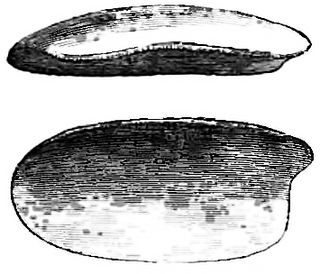The meat-cutter or native knife—Dabba—(Fig. 151)—is made by fixing to a short hard piece of wood (such as that used for spears), with the gum of the xanthorrhœa, fragments of quartz. It looks like a saw, but it is really a knife, and is employed by the natives to cut or jag flesh. This implement is mentioned by the Rev. J. G. Wood, and its uses, I think, have been misunderstood.[1]

|
| FIG. 151. |
The native scoop or spade—Waal-bee—(Fig. 152)—is used for digging roots and holding water. It is made of the outside wood of trees of the eucalyptus tribe, and is formed first by burning it so as to hollow it roughly, and is finished by scraping it with sharp stones and shells, and polishing it with a rasp made of the bark of the Banksia. It is a kind of Tarnuk, but is thinner and better formed, somewhat like a kava bowl without the feet. It is spoon-shaped, and is sixteen inches in length and seven and a half inches in breadth. Mr. Barlee says that this implement is not at all common in West Australia.

|
| FIG. 152. |
The other implements used by the natives are a waddy or club, formed of the same kind of wood as the spears, and a large war club (Weerba). The latter is made of very heavy wood, and is found only amongst the natives of the north-west coast.
Amongst their ordinary implements are bone-needles or skewers, and awls or piercers, also of bone; and they use likewise shells, sand, and rough rasps made of the bark of trees.
Mr. H. Y. L. Brown sent me a ball of twine (Noom-bine) composed of the wool of the opossum, which the natives wrap round the head or the arms or the body. A warrior places a bright-colored feather in this when it is wound round his head; and with his cloak of opossum skins, his spear, throwing-stick, and tomahawk, he is ready for peace or war.
- ↑ Natural History of Man, vol. II., p. 35.
